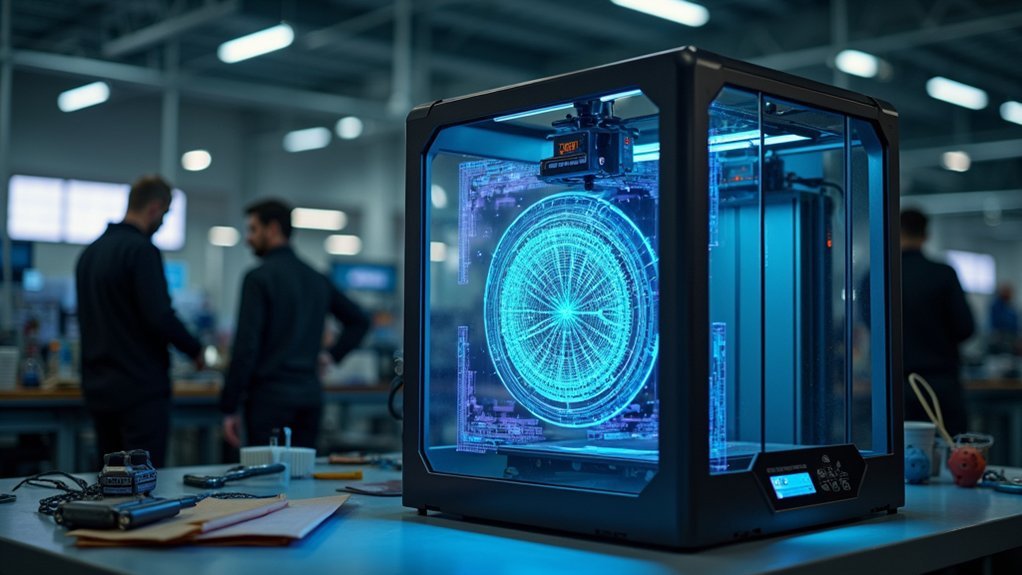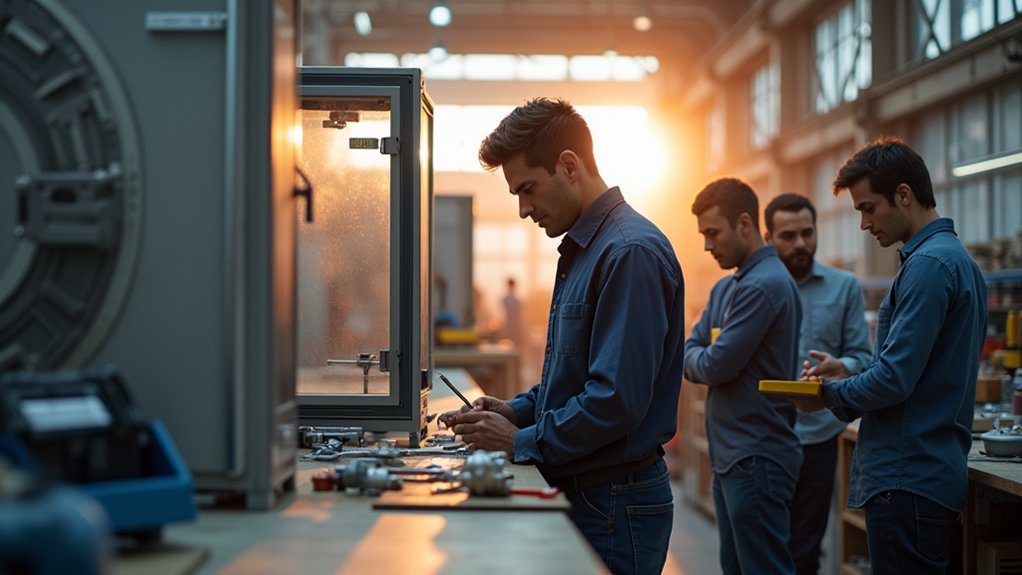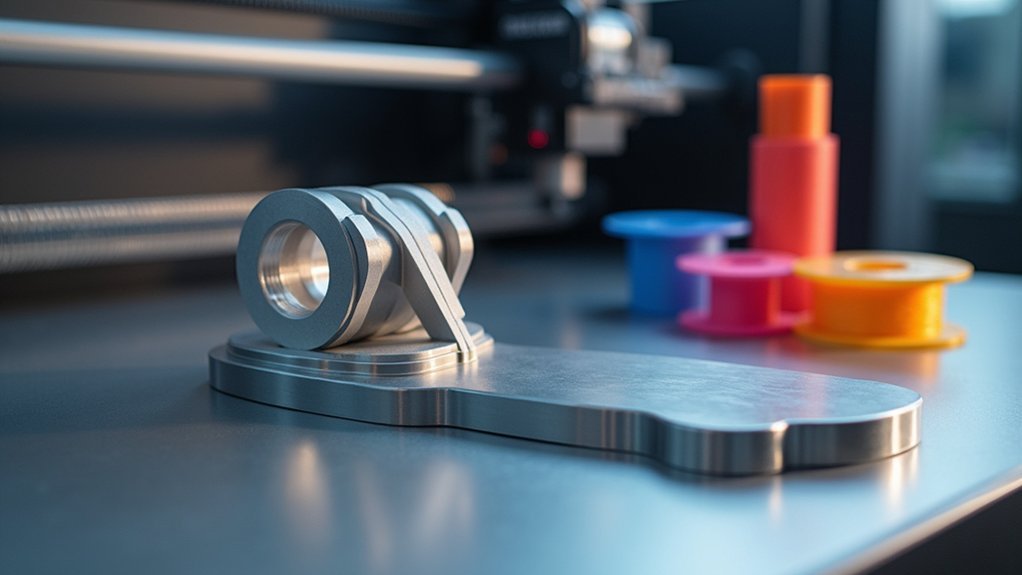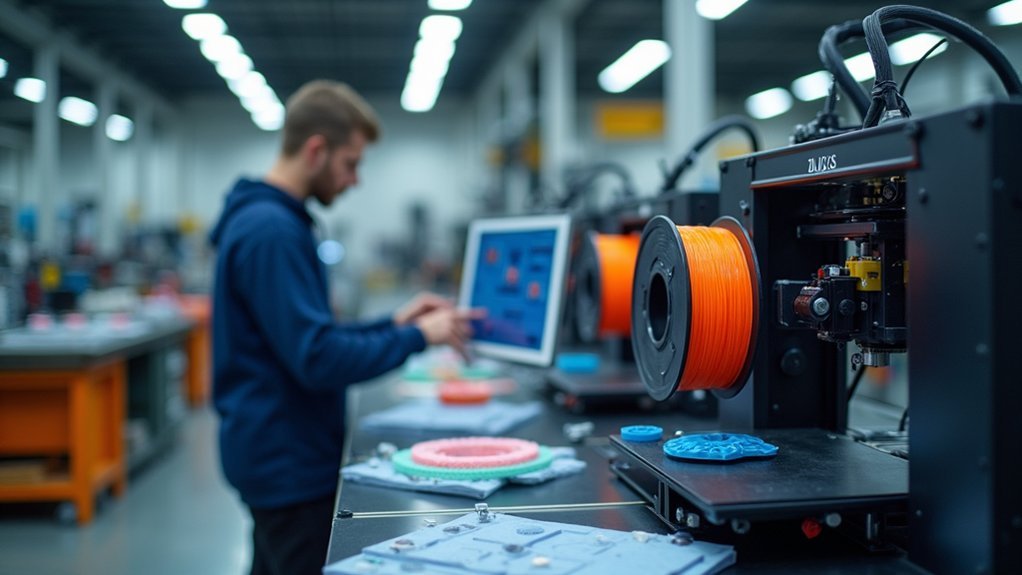You can dramatically boost your industrial 3D printing production by implementing seven key strategies: advanced design optimization through generative design and topology optimization, rapid prototyping to reduce development cycles from months to days, thorough personnel training and equipment maintenance, seamless integration with existing manufacturing workflows, strategic part consolidation for material efficiency, establishing distributed manufacturing networks for localized production, and adopting large-format multi-material printing technologies. These proven approaches help manufacturers achieve up to 50% faster production cycles while reducing costs and waste, transforming operations from bottlenecks into competitive advantages that reveal unprecedented efficiency gains.
Implement Advanced Design Optimization Techniques

Transform your 3D printing production by implementing advanced design optimization techniques that revolutionize how you approach part development.
Generative design and topology optimization algorithms create innovative designs that minimize material usage while maximizing performance. You’ll accelerate product development by reducing production cycles from months to days, enabling rapid prototyping and faster market entry.
These techniques reveal complex geometries and internal lattice structures impossible with traditional manufacturing, creating lighter yet stronger components.
The automotive industry exemplifies this potential, producing optimized parts that reduce fuel consumption and support sustainability goals.
You’ll achieve substantial cost savings through improved production yields and reduced waste.
Leverage Rapid Prototyping for Accelerated Development Cycles
While traditional manufacturing confines you into lengthy development cycles, rapid prototyping through 3D printing releases unprecedented speed in bringing concepts to reality.
You’ll move from concept to testing in days rather than weeks, transforming your product development approach. With 72% of manufacturers already utilizing this technology, you can’t afford to fall behind in accelerated development.
With 72% of manufacturers already leveraging 3D printing’s speed advantage, staying competitive means embracing days-not-weeks development cycles.
You’ll reveal complex design possibilities that traditional methods can’t achieve, creating intricate geometries and internal structures.
Companies like Ford demonstrate this power, reducing lead times for assembly tools by 50%. Your production cycles become more responsive to market demands and customer feedback, enabling multiple iterations without substantial costs.
This agility transforms how you adapt strategies, making your development process truly competitive.
Invest in Personnel Training and Equipment Maintenance

Although rapid prototyping accelerates your development timeline, you’ll only maximize 3D printing’s potential when your team masters the technology and maintains equipment at peak performance.
| Training Focus | Benefits | Impact on Production |
|---|---|---|
| Advanced 3D printing technologies | Improved operator skills | Enhanced production efficiency |
| Design optimization techniques | Better printed parts quality | Complex geometries achievable |
| Equipment maintenance protocols | Extended printer lifespan | Lower operational costs |
| Emerging materials knowledge | Innovation capabilities | Improved adaptability |
| Error prevention methods | Reduced printing failures | Minimized material waste |
Personnel training guarantees your operators skillfully handle sophisticated equipment while reducing errors throughout the printing process. Regular equipment maintenance prevents unexpected breakdowns and extends your printers’ lifespan, directly lowering operational costs. Companies prioritizing both training and maintenance experience up to 30% increased production yield with considerably reduced downtime, directly boosting profitability.
Integrate 3D Printing With Existing Manufacturing Workflows
Seamless integration of 3D printing into your existing manufacturing workflows transforms prototyping timelines from weeks to mere days while greatly enhancing production efficiency.
You’ll discover that 72% of manufacturers have already embraced rapid prototyping through additive manufacturing, achieving greater design flexibility and customization capabilities.
Your tooling strategies can benefit greatly from this integration—57% of manufacturers now use 3D printing for fixtures and tools, reducing both costs and lead times.
Ford’s impressive 50% cost reduction in assembly tools demonstrates the technology’s potential for substantial savings.
You can also leverage 3D printing for on-demand spare parts production, minimizing inventory costs while reducing machine downtime.
This strategic integration complements traditional manufacturing techniques, creating a hybrid approach that maximizes operational efficiency.
Utilize Part Consolidation and Material Efficiency Strategies

Part consolidation revolutionizes your manufacturing approach by dramatically reducing component counts while maximizing material efficiency throughout production.
You’ll transform complex assemblies into single, integrated parts using 3D printing technology, eliminating multiple components and streamlining your assembly processes.
Material efficiency strategies enable you to create complex geometries with internal lattices that deliver superior performance while using considerably less material.
You can reduce costs by minimizing waste—achieving up to 90% material waste reduction compared to traditional manufacturing methods, greatly enhancing sustainability.
Aerospace industries exemplify these benefits, with companies like ArianeGroup reducing rocket injector assemblies from 248 components to one part.
Establish Distributed Manufacturing Networks
While traditional manufacturing often requires centralized facilities and extensive shipping networks, distributed manufacturing transforms your production strategy by creating localized 3D printing nodes across multiple geographic locations. You’ll minimize supply chain risks by sending design files instead of physical products, enabling on-demand production wherever needed.
| Benefit | Traditional Manufacturing | Distributed Manufacturing |
|---|---|---|
| Production Speed | Weeks/months | Hours/days |
| Customization | Limited/expensive | Flexible/cost-effective |
| Transportation | High carbon footprint | Minimal shipping |
This approach enhances your operational efficiency through rapid prototyping and customization capabilities. You’ll achieve greater sustainability by reducing carbon footprints associated with long-distance transportation. Distributed manufacturing networks provide unprecedented flexibility in production capabilities, allowing you to respond quickly to regional market demands without significant capital investment in new facilities, ultimately boosting your overall efficiency.
Adopt Large-Format and Multi-Material Printing Technologies
When you integrate large-format additive manufacturing (LFAM) and multi-material printing technologies into your production workflow, you’ll release the capability to manufacture components that were previously impossible or economically unfeasible with traditional 3D printing methods.
LFAM enables you to produce larger components with increased efficiency while reducing assembly requirements and enabling rapid prototyping of considerable parts.
Multi-material printing allows you to combine different materials in single prints, creating complex parts with varied properties essential for aerospace and automotive applications.
This technology enhances design freedom by letting you experiment with innovative geometries and functional gradients.
You’ll greatly reduce production costs and lead times, streamlining processes while maintaining competitive advantages across manufacturing industries.
Frequently Asked Questions
How Can 3D Printing Be Improved?
You can improve 3D printing by enhancing material properties, implementing advanced monitoring systems, increasing repeatability through better calibration, optimizing designs with generative techniques, and expanding engineering-grade material availability for complex components.
What Is the 45 Degree Rule for 3D Printing?
You should keep overhangs under 45 degrees from vertical when designing 3D prints. This prevents sagging, reduces support structure needs, cuts material costs, and improves surface finish quality.
How to Promote 3D Printing?
You’ll promote 3D printing by showcasing cost savings like Ford’s 50% reduction, highlighting rapid prototyping benefits, demonstrating customization capabilities, emphasizing material efficiency, and presenting breakthrough applications like ArianeGroup’s component consolidation achievements.
How to Expand a 3D Printing Business?
You’ll expand your 3D printing business by diversifying into aerospace, automotive, and healthcare markets, investing in large-format equipment, partnering with OEMs, focusing on rapid prototyping services, and offering customized solutions.





Leave a Reply